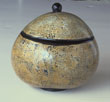Woodworking in Vietnam
Other Crafts
"The Hue [imperial] Court didn't distinguish the artist
from the craftsman," noted the French authors of Vietnam, Civilization
& Culture, a somewhat eccentric book I picked up in Hue. The book provides
a handy listing of some crafts and where they were traditionally practiced.
For the modern traveler, a typical tourist guide would be equally helpful. Although
interesting crafts are available for sale or viewing in all parts of the country,
some areas are more reknown. For example, the village of Bat Trang, a counterpart
of Don Ky as another "craft village" located near Hanoi, is famous
for its ceramics. Like Don Ky, Bat Trang has low tech factories, in which handcrafted
materials are made to look as uniform as machine made. Other traditional crafts
include lacquerware, basket-weaving, construction of water puppets, paper-making
and stone-carving.
Click
on any picture to enlarge
 |
Painters painting ceramics, Bat Trang. |
 |
A small container (bowl with lid) from Bat Trang. Ceramics are molded
(not thrown), then handpainted. Pale ceramics are reputed to be safe to
eat from, but darkly painted containers - many items are a wonderful deep
blue - are covered with lead-filled paints. |
 |
A ceramic tea pot from Bat Trang with ornamental touches. |
 |
Baskets with lids from Hanoi (origins unknown). Baskets in an amazing
range of sizes can be bought at any big market and from many street sellers,
who may carry their wares on a big pole. |
 |
Lacquerware with eggshell inlay. A bowl with lid like this is used for
hot foods, such as rice. |
 |
Lacquerware with eggshell inlay on ceramicware. Lacquerware is made
from a sap from the aptly-named lacquer tree (cay son in Vietnamese). |
 |
A carved stoneware tea set in the shape of a dragon. The accompanying
tea cups, which rest on areas decorated with mother-of-pearl inlay, seem
tiny to Westerners but are actually a standard Vietnamese size. |
 |
An incense burner from Bat Trang. Most of the ceramicware marketed to
tourists is also purchased by the Vietnamese themselves for use in their
shrines or homes. Even the most celebrated temples may include some of this
ceramicware. |


Copyright 1999 01 Inc., NYC







